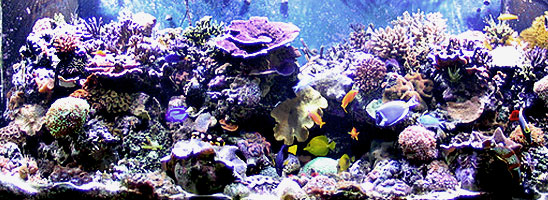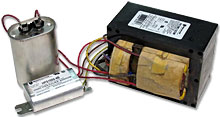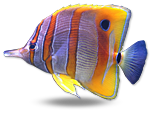
Metal Halide Aquarium Lighting
Metal halide aquarium lighting is the lighting of choice for many reef aquarists. Metal halides produce more lumens per watt than any other aquarium lighting source.
- Metal halide lamp
- Ballast
- Lamp socket and mounting bracket
- Reflector
Metal Halide Lighting System Components

Metal Halide Aquarium Bulbs & Lamps
Metal halide lamps, often referred to as bulbs, are available in 2 styles; single-ended screw type base and double-ended plug style.
What differentiates aquarium metal halide lamps from industrial or commercial grade metal halides is the spectrum. Metal halides designed for freshwater planted aquariums should be between 5500K-6500K, closely matching natural sunlight.
Reef aquarium metal halide bulbs are between 10,000K-20,000K. Lamps with a higher Kelvin rating will appear more blue whereas lamps with a lower kelvin rating will appear more white or yellow.
The typical lifespan of a metal halide aquarium bulb is about 12 months.
For a list of aquarium metal halide bulbs and their corresponding ANSI codes, view the Metal Halide Bulb and Ballast Cross Reference Guide.
Single Ended Metal Halide Bulbs

SINGLE ENDED MOGUL METAL HALIDE BULB
Watts: 175w, 250w, 400w, & 1000w
One of the most frequently asked questions when it comes to metal halide lighting is which bulb is compatible with which magnetic ballast.
Most American made bulbs are going to be probe start bulbs, meaning that they have a starting electrode built into the bulb. Most European made bulbs are going to be pulse start bulbs, meaning that they are designed to operate on a ballast that has an igniter wired in the circuit. Often times probe start bulbs will run on pulse start magnetic ballasts, but doing so runs the risk of shortened bulb life and is not recommended by most manufacturers.
An electronic or digital ballast can run any bulb at the rated wattage. These ballasts run cooler and consume less energy as compared to standard magnetic ballasts.
Double Ended HQI Metal Halide Bulbs

DOUBLE ENDED HQI METAL HALIDE BULB
Double-ended metal halide bulbs, often referred to as HQI, must be used with either an electronic ballast or a magnetic ballast designed to operate HQI bulbs.
HQI bulbs must be used in a fixture with a glass shield to block the intense ultraviolet rays emitted.
Metal Halide Aquarium Ballasts

ELECTRONIC METAL HALIDE BALLAST
Metal Halide Magnetic Ballasts
The three types of magnetic ballasts commonly used in the aquarium hobby are probe start, pulse start, and HQI.
Ballast components consists of a capacitor and a coil. The probe start bulb has an igniter built in.
ANSI Codes: 175watt/M57 250watt/M58 400watt/M59 1000watt/M47
Ballast components consists of a capacitor, a coil, and an igniter.
ANSI Codes: 175watt/M137 250watt/M138 400watt/M135 1000watt/M141
The HQI magnetic ballast is specifically designed to operate double ended HQI metal halide bulbs only.
ANSI Codes: 70watt/M85 150watt/M81 250watt/M80

ELECTRONIC METAL HALIDE BALLAST
Metal Halide Electronic Ballasts
Aquarium electronic metal halide ballasts are superior over magnetic ballasts because they will drive any bulb of the rated wattage.
Electronic metal halide ballasts produce less heat and consume less electricity, making them much more efficient than traditional ballasts.
Some electronic metal halide ballasts are available with a dimming switch.

